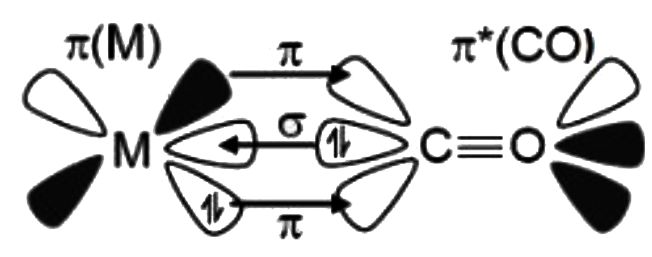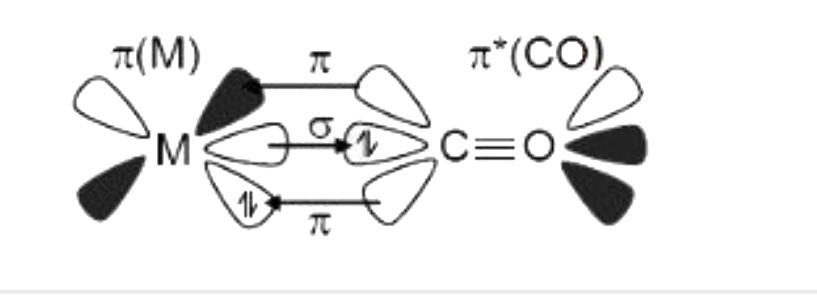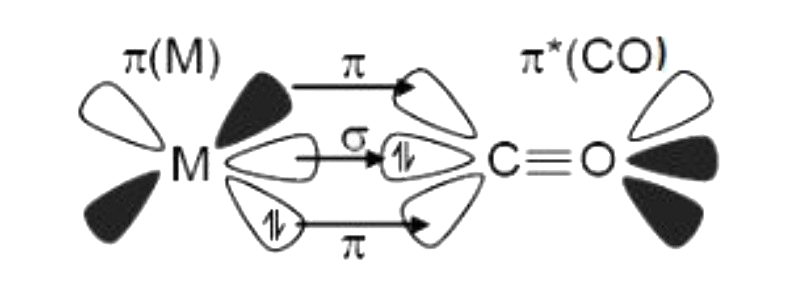Metal 'M' forms a carbonyl compound in which it is present in its lower valance state. Which of the following bonding is possible in this metal carbonyl?




The correct Answer is:B
To solve the question regarding the bonding in a metal carbonyl where the metal 'M' is in its lower valence state, we will analyze the bonding interactions that occur between the metal and the carbonyl ligand (CO).
1. Understanding Metal Carbonyls:
- Metal carbonyls are complexes formed between a metal and carbon monoxide (CO) ligands. In these complexes, CO acts as a ligand that can donate electron density to the metal.
2. Identifying the Valence State of Metal 'M':
- The question states that metal 'M' is in its lower valence state. This is important because it influences the types of bonds that can form between the metal and the CO ligands.
3. Sigma Bond Formation:
- The carbonyl carbon has a lone pair of electrons that can be donated to the vacant d-orbitals of the metal. This results in the formation of a sigma (σ) bond.
- The interaction can be represented as:
CO (lone pair)→Metal (vacant d-orbital)
4. Pi Bond Formation:
- In addition to sigma bonding, there is also the possibility of pi (π) back-bonding. This occurs when the filled d-orbitals of the metal can donate electron density to the empty π* (anti-bonding) orbitals of the CO.
- The interaction can be represented as:
Metal (filled d-orbital)→CO (π*)
5. Analyzing the Options:
- The question asks which bonding is not possible in this metal carbonyl. We need to evaluate the provided options based on our understanding of sigma and pi bonding.
- Option A: If it suggests that the metal donates electrons to a π* orbital of the metal itself, this would be incorrect as back-bonding occurs with the CO's π* orbital.
- Option B: If it describes the correct sigma and pi bonding interactions, this is a valid bonding scenario.
- Option C: If it suggests incorrect sigma bonding interactions, this would also be invalid.
- Option D: Similar to option C, if it describes incorrect interactions, it would be invalid.
6. Conclusion:
- After evaluating the bonding interactions and the options, we conclude that the bonding that is not possible is the one where the metal donates electrons to its own π* orbital, as this does not occur in metal carbonyls.
Final Answer:
The bonding that is not possible in this metal carbonyl is the one where the metal donates electrons to its own π* orbital.
---
- Metal carbonyls are complexes formed between a metal and carbon monoxide (CO) ligands. In these complexes, CO acts as a ligand that can donate electron density to the metal.
- The question states that metal 'M' is in its lower valence state. This is important because it influences the types of bonds that can form between the metal and the CO ligands.
- The carbonyl carbon has a lone pair of electrons that can be donated to the vacant d-orbitals of the metal. This results in the formation of a sigma (σ) bond.
- The interaction can be represented as:
CO (lone pair)→Metal (vacant d-orbital)
- In addition to sigma bonding, there is also the possibility of pi (π) back-bonding. This occurs when the filled d-orbitals of the metal can donate electron density to the empty π* (anti-bonding) orbitals of the CO.
- The interaction can be represented as:
Metal (filled d-orbital)→CO (π*)
- The question asks which bonding is not possible in this metal carbonyl. We need to evaluate the provided options based on our understanding of sigma and pi bonding.
- Option A: If it suggests that the metal donates electrons to a π* orbital of the metal itself, this would be incorrect as back-bonding occurs with the CO's π* orbital.
- Option B: If it describes the correct sigma and pi bonding interactions, this is a valid bonding scenario.
- Option C: If it suggests incorrect sigma bonding interactions, this would also be invalid.
- Option D: Similar to option C, if it describes incorrect interactions, it would be invalid.
- After evaluating the bonding interactions and the options, we conclude that the bonding that is not possible is the one where the metal donates electrons to its own π* orbital, as this does not occur in metal carbonyls.
The bonding that is not possible in this metal carbonyl is the one where the metal donates electrons to its own π* orbital.
Similar Questions
Knowledge Check
- Question 1 - Select One
Which of the following carbonyl compounds is most polar ?
AC2H5−O||C−C2H5BCH3−O||C−CH3CCH3−O||C−HDH−O||C−H - Question 2 - Select One
Which of the following metals is present in chlorophyll ?
AMgBBeCCaDnone of these.
The complex compound in which metal is not present in zero oxidation state?
View SolutionWhich of the following does not apply to bonding in metals ?
View SolutionIn Which of the following metal to metal bond is present?
View SolutionWhich of the following does not have a metal carbon bond?
View SolutionWhich of the following is not a metal carbonyl?
View SolutionIn which of the following metal to metal bond is present ?
View Solution

